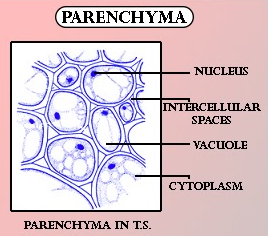
Answer
395.7k+ views
Hint: They are simple permanent tissues which make a major part of the ground tissues in plants and are embedded in the vascular tissues. They are of various types based on their location and functions differently.
Complete answer:
Parenchyma cells are relatively unspecified and thin-walled. The water storage tissue in desert plants are also parenchymatous cells named aquiferous parenchyma having a thin-walled, large-sized structure with a large vacuole inside it that helps them to store water. The vacuole or the cytoplasm contains the mucilage that helps them in increasing the capacity of the water retention or water storage.
Parenchyma is round or oval-shaped cells having spaces between them and they are simple tissues are tissues composed of cells that are structurally and functionally similar i.e. they are made up of the same type of cells. They are found in the leaves, stems, fruits, etc, and help in food storage. Chlorenchyma is the type of parenchyma that consists of chloroplast and helps during the process of photosynthesis. The aerenchyma is the type of parenchyma found in aquatic plants having large air spaces that helps them in floating. The parenchyma performs various functions that include photosynthesis, gaseous exchange, storage of food, etc. They are the main plant tissue that composes mostly the whole plant body.
Types of parenchyma:
There are four sorts of parenchyma consistent with their function:
-Photosynthetic parenchyma of camellia leaf.
-Storage parenchyma of the buttercup root cortex.
-Aquiferous parenchyma of a cactus.
-Aeriferous parenchyma of a rush stem.
So, the correct answer is ‘All of the above’.

Note:
The parenchyma cells were discovered in the seventeenth century for the first time by Robert Hooke. The chloroplast is composed of the parenchyma cells that are composed of two parts, the outer part is called the cortex while the inner layer is the pith. The soft tissues of the fruits are also formed by the parenchyma cells.
Complete answer:
Parenchyma cells are relatively unspecified and thin-walled. The water storage tissue in desert plants are also parenchymatous cells named aquiferous parenchyma having a thin-walled, large-sized structure with a large vacuole inside it that helps them to store water. The vacuole or the cytoplasm contains the mucilage that helps them in increasing the capacity of the water retention or water storage.
Parenchyma is round or oval-shaped cells having spaces between them and they are simple tissues are tissues composed of cells that are structurally and functionally similar i.e. they are made up of the same type of cells. They are found in the leaves, stems, fruits, etc, and help in food storage. Chlorenchyma is the type of parenchyma that consists of chloroplast and helps during the process of photosynthesis. The aerenchyma is the type of parenchyma found in aquatic plants having large air spaces that helps them in floating. The parenchyma performs various functions that include photosynthesis, gaseous exchange, storage of food, etc. They are the main plant tissue that composes mostly the whole plant body.
Types of parenchyma:
There are four sorts of parenchyma consistent with their function:
-Photosynthetic parenchyma of camellia leaf.
-Storage parenchyma of the buttercup root cortex.
-Aquiferous parenchyma of a cactus.
-Aeriferous parenchyma of a rush stem.
So, the correct answer is ‘All of the above’.

Note:
The parenchyma cells were discovered in the seventeenth century for the first time by Robert Hooke. The chloroplast is composed of the parenchyma cells that are composed of two parts, the outer part is called the cortex while the inner layer is the pith. The soft tissues of the fruits are also formed by the parenchyma cells.
Recently Updated Pages
Who among the following was the religious guru of class 7 social science CBSE

what is the correct chronological order of the following class 10 social science CBSE

Which of the following was not the actual cause for class 10 social science CBSE

Which of the following statements is not correct A class 10 social science CBSE

Which of the following leaders was not present in the class 10 social science CBSE

Garampani Sanctuary is located at A Diphu Assam B Gangtok class 10 social science CBSE

Trending doubts
A rainbow has circular shape because A The earth is class 11 physics CBSE

Which are the Top 10 Largest Countries of the World?

Fill the blanks with the suitable prepositions 1 The class 9 english CBSE

How do you graph the function fx 4x class 9 maths CBSE

The Equation xxx + 2 is Satisfied when x is Equal to Class 10 Maths

What is BLO What is the full form of BLO class 8 social science CBSE

Give 10 examples for herbs , shrubs , climbers , creepers

What organs are located on the left side of your body class 11 biology CBSE

Change the following sentences into negative and interrogative class 10 english CBSE




